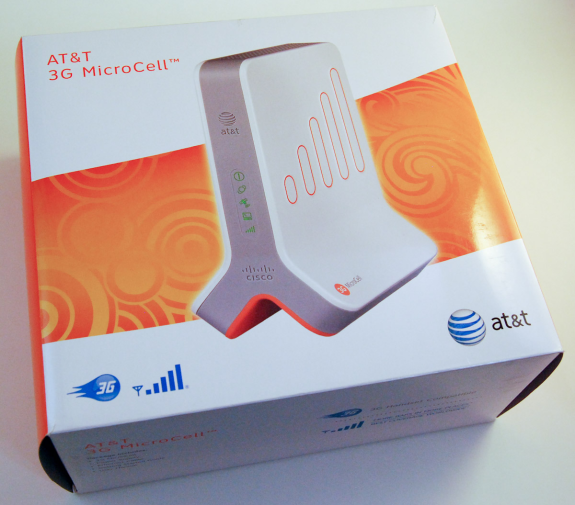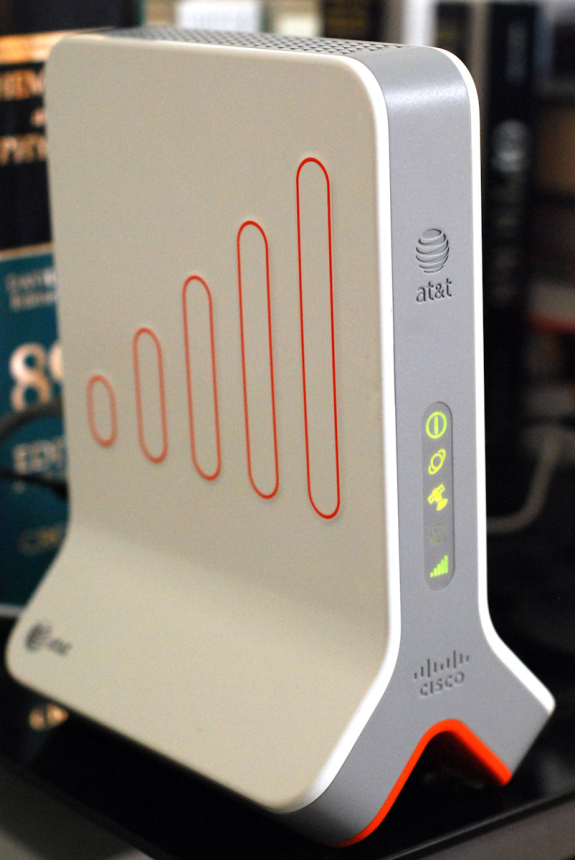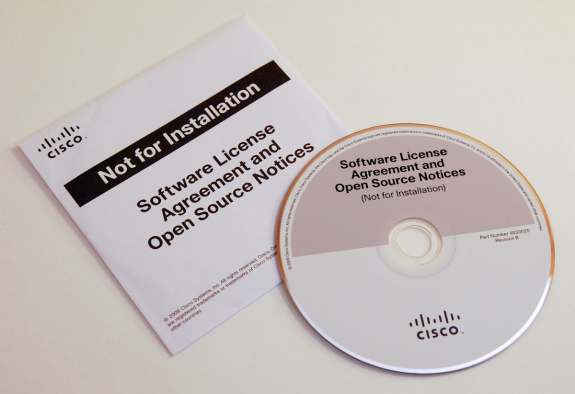AT&T 3G MicroCell: A Comprehensive Exploration
by Brian Klug on April 1, 2010 1:55 AM EST- Posted in
- Smartphones
- AT&T
- Microcell Review
- Mobile
Inside is just about everything you'd expect. There's a standard quick getting started guide if you're reading-challenged, an equally straightforward but more hefty users manual, power supply, and a yellow ethernet cable. Then there's the device itself, bearing Cisco branding and AT&T logos. On its front are five status LEDs: power, ethernet, GPS, computer, and 3G cellular.
The "computer" status LED is interesting - Cisco suggests connecting the microcell in-line with your internet connection, before your router in what they call a "priority mode" configuration. This makes sense, as it offers an easy connection method for users that either don't know about QoS, NAT, or port forwarding, or aren't competent enough to configure them. I didn't investigate priority mode in much detail, instead using QoS and port forwarding rules of my own, but more on that later.
Powered up and running - your very own "cancer box"
On the back are two ethernet ports. The yellow one is what we're interested in, as this is the primary connection for internet. The black one is labeled "computer," and as noted earlier and is for connecting another device behind and in line with the microcell - ostensibly a router or your computer if you lack one. There's also an antenna jack for connecting an external GPS antenna if you can't install the device near a window, or if your windows have a coating which attenuates GPS frequencies. AT&T offers absolutely no guidance of any kind about what type of port this is, but from experience it appears to be MMCX or possibly RP-MMCX. There's also a reset pin hole and power adapter.
Backside of the AT&T MicroCell
Interestingly, there's also an open source license agreement notice CD and sleeve. I half expected a complete dump of all the relevant code given the CD, but instead of Cisco effectively using the 700 MB of storage, they parked one 591 kilobyte, 281 page long PDF document with all the FOSS licenses for packages used on the MicroCell. No, I'm not even joking, this CD literally has one half megabyte file on it. What's even more hilarious is that the file is actually linked for download during the registration process, which makes a heck of a lot more sense.
Not for installation - for reading during that long activation process
Of course, for your amusement, I went through the whole document and extracted all the open source packages cited. There are 24 licensed pieces of software, but the takeaway is that the femtocell is running BusyBox 1.8.2. Ostensibly, most of the code is being used for routing packets through what amounts to a router when you've put the device in "priority mode," but as we'll discover later there's plenty more going on too.














63 Comments
View All Comments
atiller - Thursday, April 1, 2010 - link
Thanks for the excellent and detailed report. One comment - your view of picocells is rather out of date. Just like femtocells, today's picocells use IP backhaul and can be installed without any specialist skills. Some people call them 'enterprise femtocells', but they have a larger capacity and range than a femto.Brian Klug - Thursday, April 1, 2010 - link
Awesome tip, thanks, I definitely didn't know about these. Do you know what kind of carrier interaction is required for installing one of those? I mean, are they carrier agnostic, some common brand, and can anyone just buy them?I think there's definitely a market for malls and large shopping centers that want to improve coverage indoors - it seems to be a systemic problems for large buildings with high population density inside.
-Brian Klug
Paulman - Thursday, April 1, 2010 - link
Except that I was reading an 4/1/2010 post on a friend's blog which made me wonder when the tech sites would start posting their crazy stories, and then I realized... wait a second...Before realizing this, I had read up to page 4 (Inside the Networking), at which point I was like, "I'm done with this article - I was just really curious to see if this was a 3G signal repeater, or if it got the data through a broadband connection and then just broadcast it locally over 3G". Lol.
TGressus - Thursday, April 1, 2010 - link
...by failed handovers on AT&T.In southern California we as a community drive a lot (serious understatement), and many careers involve driving throughout the work day. Certain devices and occupations have moved my colleagues and family to AT&T at times, including the present. Everyone I know is regularly affected by the worst case handover scenarios you were surprised about in your article.
It so predominant that I estimate 1/4 of my calls with AT&T I answer, "sorry, dropped call" rather than, "hello". It is the consensus of the mobile professionals with whom I interact through AT&T that one can not afford to make important phone calls on the road. I know that must seem like the most obvious statement ever, but try and empathize here; the nature of many businesses in massive urban sprawl lends itself to perpetual mobile telephony.
People regularly attribute these issues to the coverage maps and, more recently, smart-phone burden. I'm no cellular techncian, but I suspect it's something more fundamental with GSM and/or AT&T technology. I'm not surprised you noticed this issue. In fact, I'm surprised you are surprised.
Brian Klug - Thursday, April 1, 2010 - link
I can't speak for the load in that area, but migrating calls and handing them over if the adjacent cell sites are overloaded is generally what causes soft handovers to fail. So imagine that you're on a node, being serviced perfectly fine, but migrate (while driving, say) into an adjacent cell that's completely overtaxed. The phone will try to migrate its session, but if it's so overloaded that it can't, the call will fail.It's a sad state of things, but that's probably what's going on if you see that you have good signal but still encounter problems. In fact, I'd say if you don't hear distortion or blocking, but rather just have the call fail (and you're moving) this is probably the case. Of course, that market is one that AT&T is particularly stressed about and focusing on now, hopefully it improves.
Both CDMA2000, GSM, and UMTS are equally robust in the soft handover arena, and it *usually* works flawlessly - this is a technology that's rolled out pretty much everywhere. The technology is robust, but it's entirely carriers prerogative to install it properly and watch out for these load issues. Nothing is going to overcome the laws of physics. ;)
Cheers,
Brian Klug
slyck - Thursday, April 1, 2010 - link
Comments so far are right on. This should be a choice of last resort only for those who are connected to their cell number. If you need internet to make your call there is always VOIP which costs far, far less.sxr7171 - Thursday, April 1, 2010 - link
Firstly pardon my language here. But this is bullshit.These stupid wireless carriers have a lot of nerve trying to extend their wireless coverage off of the customer's dime. On top of the ridiculous prices they charge for voice and data and most importantly: SMS. They have a lot of nerve asking customers to pay for the device and to pay for calls on it.
The only advantage this has over a VOIP solution is basically seamless hand-offs - WHICH THIS CRAP PRODUCT DOES NOT DO.
For GSM users this functionality was built into the standard and has been around for years and was mentioned in the article: SIP. T-mobile uses it but they restrict the devices.
SIP is a feature built into many open unlocked phones like Symbian phones from Nokia and others, but our US carriers don't like such open phones so they would never allow a carrier sponsored phone to have the SIP software intact in the FW/OS. The whole technology was designed around having a choice of cell phone provider and SIP provider - you know choice as in the kind that creates competition. But our carriers will never allow that, and our consumers will always get sucked into carrier contracts and locked phones. This sort of thing is what makes it impossible to launch a phone or technology without the carrier's blessing and it is what makes us indentured to carriers.
That iPhone is not $200 always remember the $1680 of overpriced service that is part of it. An unlocked iPhone costs $999. Think about why that is. It's because with the carriers control the device prices since they control who can buy it and what services must be purchased and how much that service costs. Will wireless ever be a free market in the US?
HotFoot - Thursday, April 1, 2010 - link
Have to agree with you. This is just silly.Where I live, there are two good solutions for the problem this device/service is trying to solve.
1) Rogers has wifi capable cell phones that will switch to using your home 802.11 (or other hotspots) for making calls. When you're on wifi with these phones, you get different rates for calls much more in line with VoIP.
2) Smart phone that will Skype over wifi. I pay $15/mo for my cell phone service plus another $3 to Skype for unlimited calling in North America. That's $18/mo, no contracts. I did pay $600 for my N900, so if that lasts me 3 years add another $18/mo to the total so I pay $36/mo to have basic cell phone service while I'm out and about and unlimited calling while at home, work, or coffee shop/anywhere there's free wifi.
Anyone feeling like this AT&T offer is a load of steaming crap in comparison?
sxr7171 - Thursday, April 1, 2010 - link
But the 2 are open technologies that were supposed to enable seamless hand-offs and choice of service provider.Wayne86 - Thursday, April 1, 2010 - link
I was hoping this article was an April Fools joke. Alas, after Topekaing, it is not. :)